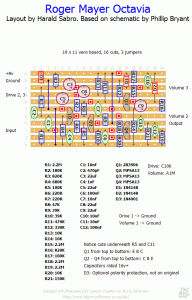Been ages since I've posted anything, but that's not to say I haven't been having some fun with building a pedal or ten...!
I happened to have been talking about fuzz pedals with a friend a while back, and as I had a few plugged in and a mic facing my AC4 I thought I'd record a quick comparison for him to have a listen as he was keen to.
The fuzzes are:
- Silicon Tonebender - not an "official" Tone Bender design as far as I'm aware, but rather an adaptation of the MkII circuit to work well with low gain Si transistors. Layout, discussion and a few more info HERE on Mark's blog.
- Devi Ever Hyperion - extremely simple to build yet great sounding fuzz from Devi Ever. Dirty attack, singing sustain, like some kind of ratty bastard son of a Big Muff. HERE you can find layout, discussion and a few more info, again on Mark's blog.
- Roger Mayer Octavia - To call it the Purple Haze fuzz would be to celebrate it and do it an injustice at the same time. Worthy of its legendary status and yet it can lend itself to so many different sounds and contexts. I built mine using the layout made by Harald at Sabrotone, which can be found HERE
Please keep in mind all fuzzes are set to maximum or thereabout so, while this demo can give you an idea of each individual pedal's tone, it won't quite showcase the range of sounds they can achieve.
Fender Jazzmaster > pedals > Vox AC4 <Shure SM57 / Play in full HD for best sound quality.
Enjoy!

.JPG)

